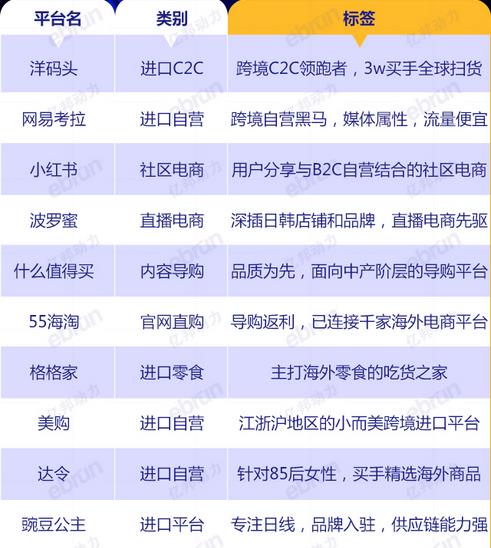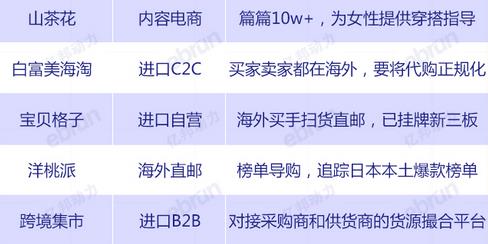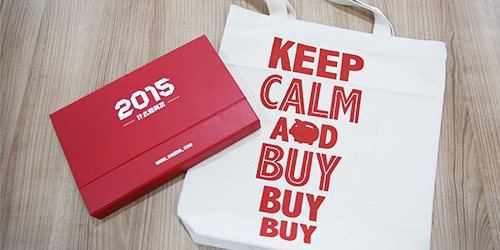The most comprehensive list of cross-border e-commerce platforms gives you a glimpse of the future.
Do what? How? E-commerce channels are very important.
Cross-border e-commerce is now blooming everywhere, and the rapid development in just a few years has led to the emergence of various cross-border platforms in the market, so that cross-border e-commerce that is a new thing is new every year, constantly refurbished and constantly innovated. Organize some excellent cross-border e-commerce platforms as follows:


1. ocean wharf
Type: imported C2C platform
Label: the leader of cross-border C2C e-commerce, 30,000 buyers help you buy it in buy buy.

Highlight: Ocean Terminal is the first player to enter the field of cross-border e-commerce, and has abandoned the traditional B2C model, allowing buyers all over the world to sweep goods in retail stores around the world and sell them to China consumers through Ocean Terminal. It was the first to "upgrade" purchasing to buyers, creating the concept of "buyer economy".
Similar to purchasing, the buyers on the ocean terminal are all independent individuals, each with "good" categories and brands, which makes the number and types of goods on the platform very large. Even very small, rare or even limited-edition products can be found on the platform. The buyers are supervised by the platform, and the quality of goods, delivery efficiency and service level are all constrained, forming a unique management system.
At present, the number of buyers on the ocean terminal has reached 30,000, and some of them have formed a team operation, with their own procurement, stocking, marketing system and fan base. The scale of the platform has been initially reflected.
2. Netease koala sea purchase
Type: imported self-operated e-commerce
Label: the dark horse of cross-border self-operated e-commerce, Netease’s physical attributes bring natural traffic recommendation to it.
Reason one: hardware foundation. Backed by Netease Group, Koala Haibao can invest a lot of money to build hardware facilities without the support of external capital. Up to now, the bonded storage area of Netease koala has reached the first in the industry in China, and there are bonded warehouses under construction in Ningbo. In addition, Netease koala also purchased Amazon’s warehouse management system to improve its warehouse management efficiency.
Recommended reason 2: the cost of obtaining customers is low. When you open any product of Netease, whether it’s email, games or news, you will see advertisements of Netease koala everywhere, and accidentally click on the purchase link, which makes people hard to prevent. It is reported that Netease products have contributed a very eye-catching position to recommend Netease koala, and any Netease user is a potential user of Netease koala.
Recommended reason 3: Dare to try. Netease had no experience to follow when it first set foot in cross-border import business. How to choose products, stocking strategy, storage structure, logistics construction and so on are all explored in the attempt. Its insiders once broke the example of "trying to make Japanese instant noodles bonded and stocking the results in the warehouse". It is this spirit of daring to try and explore that gives Netease koala rich experience and helps its business grow.
3.jackfruit
Type: live e-commerce
Label: Show the interior of Japanese and Korean shops and brand enterprises to users in the form of video, the pioneer of live e-commerce.
Highlight: Founded in 2015, Paramita is almost the first platform to integrate live broadcast with cross-border e-commerce, although it is very young. After that, the live broadcast of the show was on fire, and various e-commerce players also played live cards.
Different from other e-commerce companies seeking traffic conversion through live broadcast in online celebrity, the content of paramita’s live broadcast is more "dry". At first, paramita was broadcast live in retail stores on the streets of Japan and South Korea to show users the real scenes of overseas offline stores; Later, paramita entered the enterprises of Japanese brands, allowing the heads of Japanese enterprises to "sell" their products through live broadcast.
Paramita’s users are mainly young women. As soon as the live broadcast starts, they will put down their work, schoolwork and children and interact while watching the live broadcast. It often happens that goods are sold out at the end of the live broadcast.
4. Little Red Book
Type: community e-commerce
Label: Community e-commerce combining user sharing with B2C self-management
Highlight: Xiaohongshu was established in 2013, and it is the first platform to skillfully integrate interactive communities with cross-border e-commerce. There are mainly two parts on it: overseas shopping sharing community with UGC model and self-operated e-commerce "welfare society", both bonded and overseas direct mail are involved.
The users of Xiaohongshu are mostly white-collar women, and many of them are extremely addicted to Xiaohongshu. When they have nothing to do, they will go to the door for a stroll, and there are not a few users who spend 18,000 yuan on it every month. Users will spontaneously share their shopping experiences, experiences and feelings in the community, and form an online "boudoir circle", and word-of-mouth publicity has continuously expanded the user base of Xiaohongshu.
5. What is worth buying?
Type: content shopping guide personality
Label: You will know what is worth buying when you come.
Recommended reason: What is worth buying is not an e-commerce in the strict sense, but it has become a bridge between the e-commerce platform and consumers, delivering product information, usage, preferential activities and other content to users.
The core purpose of what is worth buying is not to provide the kind of shopping guide that only drives users to buy by price, but to enable users to get in touch with more and better products, which are also the most cost-effective. Its customer base is defined as "the growing middle class", which has certain consumption power and pursues quality, among which male users account for about 60%.
The Haitao section on it brings together all kinds of information of overseas e-commerce platforms, brands and cross-border e-commerce, and introduces the preferential activities of overseas goods and platforms worth buying to users. Long tail models are the main products to be transformed, and clothing, watches, toys and 3C are all involved.
6.55 Haitao
Type: official website Direct Purchase Platform
Label: shopping guide rebate, connected to thousands of overseas e-commerce platforms.
Highlight: With the rapid development of cross-border e-commerce, there are still many experienced Haitao users who are used to going to overseas e-commerce platforms for traditional Haitao. 55 Haitao serves these users to a certain extent, and thousands of overseas e-commerce platforms are gathered on it, which are completely synchronized with their commodity libraries. Haitao also provides many transshipment companies for users to choose from.
Different from overseas e-commerce Haitao, these overseas platforms will provide users with different degrees of rebates, and the rebate will increase during the promotion period. For those users who have no experience in Haitao, a large number of overseas e-commerce companies gathered on 55 Haitao that support Chinese services and direct mail to China are enough for them to choose for a while.
Overseas e-commerce websites are all here. How to choose and choose what depends on the ability of users. I don’t know if it doesn’t matter if I visit you. In the forum section of 55 Haitao, Haitao experts will also give advice to new users in their respective areas of expertise and share their own strategies.
7.gegejia
Type: imported snacks
Label: Cross-border e-commerce that focuses on overseas snacks, and the foodie boss eats and eats with foodie users.
Highlight: Gegejia’s goal is to become the top 10% platform for high-end food consumption in China, and bring delicious food from all over the world to China. Its founder, Li Xiao, used the word "delicious" most when evaluating his home platform. In short, it is a gathering place for eating goods.
But when eating, Gege’s family also played tricks. When the Gege family just announced that they were going to play live in online celebrity, people could not help wondering: What is the live broadcast? Do you eat live? But when you think about it carefully, it is really convincing to let a fat girl/boy recommend snacks.
8. American purchase
Type: import self-operated
Label: Small but American cross-border import platform in Jiangsu, Zhejiang and Shanghai.
Highlight: The United States does not buy much. At present, it only serves areas in Jiangsu, Zhejiang and Shanghai, but she is really small and beautiful.
American buyers mainly promote overseas goods including snacks, fruits, personal care and mothers and babies. The source of goods is directly provided by overseas brands or agents, and bonded warehousing cooperates with companies such as Shanghai Cross-border Communication, Cosco and Volkswagen Storage.
U.S. purchases are delivered by Sagawa ZJS, and the packaging boxes of each order are very beautiful, and the packages delivered to users will not be damaged, stained or deformed. In the Jiangsu, Zhejiang and Shanghai areas covered by American purchases, it has achieved the same day or the next day, and the logistics experience is good.
Customer service is a more important aspect of American purchase. Its co-founder Yu Ran often actively communicates with customer service staff, and also establishes his own user base to communicate with users in depth.
9. Darling
Type: import self-operated
Label: For post-80s white-collar women, buyers select overseas goods to restore the shopping scene.
Highlight: Darling represents freshness and surprise, and the selection of products and services are all around users. What goods users need, darling will expand the category accordingly; Users are most active from 7: 00 to 8: 00 in the morning, and Darling finished updating before 7: 00.
Darling insists on self-operated direct mining, and it has an international buyer team all over the world. China buyers choose the products that meet the needs of Darling users, while overseas buyers take direct purchases or negotiate with brands.
Lu Han, a popular idol, was also "bought" by Darling, and his massive fans injected a lot of traffic into Darling. In addition, Darling has also conducted cross-border cooperation with movies and matchmaking websites to further expand the territory.
10.princess and the pea
Type: Japanese import platform
Label: focus on the daily line, Japanese brands directly settle in, and have strong supply chain capabilities.
Highlight: princess and the pea has strong Japanese genes and adopts the mode of combining self-management and open platform. A large number of Japanese small and medium-sized brand resources have settled in the platform, and all products are directly mailed to China.
These Japanese brands are small in scale, but many of them are traditional enterprises and family businesses with decades of history. In order to let users in China know about their products, princess and the pea has made corresponding introduction videos for each brand or even single product, so as to let consumers in China know about these brands and understand the function, quality and concept of the products in our customary way.
While developing its own platform, princess and the pea has also reached in-depth cooperation with Taobao’s global supply and marketing platform, providing the latter with supply chain resources of Japanese goods, and providing more choices for Taobao’s individual merchants to cooperate with overseas brands through systematic channels and brand management.
11. Camellia
Type: content e-commerce
Label: WeChat official account’s articles are 100,000+,providing guidance for young women and providing transactions.
Highlight: Camellia combines the three elements of content, community and e-commerce, and continues to export good products and good content to women. Users can see what different women wear in different scenes on the camellia platform, and can buy women’s clothing products around the world with one click through its global database.
When providing a piece of content, camellia often gives users a scene and reason to buy, and thinks about what kind of products they need and under what circumstances they will buy from the user’s point of view. Camellia is not sold to users after purchasing, but the development direction of its supply chain is determined by users. Good content not only affects the user level, but also affects the supply chain behind it.
12. Bai Fumei Haitao
Type: imported C2C
Label: "Didi" in Haitao, buyers and sellers are overseas, and purchasing should be regularized.
Highlight: BFME was established in Hong Kong in 2015. Its buyers are all Chinese living abroad, who know what local people buy and where to buy them. This is more accurate and flexible than an e-commerce platform’s overseas direct purchasing, and it also buys goods commonly used by local people, instead of just selling them to Chinese’s "China for exclusive use".
Bai Fumei’s main battlefield is overseas, and buyers are often overseas Chinese. It has also deployed a large number of pushers in overseas stores and retail stores, transforming shopping tourists into platform users, so that they will still place orders on the platform after returning home.
Compared with other e-commerce platforms, Bai Fumei is more like a service-oriented platform. Its direction is to move the traditional Haitao purchasing industry from offline to a "sunny" online platform, and aggregate scattered and fragmented purchasing behaviors to provide them with services and support.
13. Baby check
Type: import self-operated
Label: Cross-border e-commerce for mothers and children who buy goods by overseas direct mail has been listed on the New Third Board.
Highlight: Baby Grid was established in 2012, and it is a cross-border e-commerce between mother and baby with overseas direct mail and global sale as the main mode. In December 2015, Baby Grid was listed on the New Third Board, becoming the first mother-infant cross-border e-commerce enterprise in China to land in the capital market. Its maternal and child strategy is to establish cooperative relations with lower-level distributors, gradually expand brand authorization, and open up the whole industrial chain of maternal and child industry with multi-brand strategy.
Baby Grid has layout in bonded warehouses and overseas warehouses. By accurately predicting sales data, we can stock up in advance, rationally allocate bonded warehouses and overseas warehouses, and optimize logistics and transportation processes to shorten the time for overseas direct mail.
In June 2016, Baby Grid also reached a cooperation with China Quality Certification Center to conduct supply chain evaluation and security traceability on platform products, so as to enhance consumers’ trust in the platform.
14. Peach pie
Type: overseas direct mail
Label: Track the explosion list in Japan and guide consumption with the mode of local list.
Highlight: I mentioned "buyer economy" before, and I will talk about "list economy" this time.
Founded in 2015, Yangtao School has an exclusive list of Japanese local products, calling on users to make purchase decisions with reference to objective sales data. Its data comes from GENEPA Co., Ltd., a famous Japanese e-commerce big data analysis company, and the list is updated every week.
At present, the Peach Blossom School has a Top10 list of more than 100 kinds of short stories in six categories: beauty, mother and baby, health care products, kitchen and bathroom, daily necessities and food. Each product has a Chinese description written by the editorial team and celebrities, and the latest comments of Japanese buyers on the products are presented simultaneously.
After the user places an order, the Peach Blossom Party will provide the back-end "one-click purchase" service. The three platforms of Amazon, Lotte and Yahoo are its main "virtual warehouses", and the prices are synchronized with these platforms.
15. Cross-border fairs
Type: Import B2B
Label: Sourcing platform, which moves the behavior of finding and selling goods in QQ WeChat group to the platform. Recommended reason: no stocking, no trading, only matching.
On the platform of the cross-border market, various sources of goods such as mother and baby, food, beauty cosmetics and health products are gathered, and suppliers of different sizes and prices can display their products on it, and buyers can choose them. This model solves three problems: first, to make the price of the industry more transparent, so that buyers can understand the market through price comparison; Second, the supply chain is shortened, and people who earn the difference by dumping goods at different levels will be eliminated; Third, help small and medium-sized B-terminals with small volume to connect with high-quality suppliers.
In order to attract suppliers, the cross-border bazaar adopted the "sea of people tactics", throwing the goods on the platform into QQ group and WeChat group to attract buyers to purchase on the platform. At the same time, suppliers were forced to enter, and the platform gradually grew.
16. Zhongxing Haisi Road
Type: personality of import service provider
Label: Transform Taiwan Province’s surplus international transport capacity into Fujian port for offshore bonded.
Highlight: Doing bonded import logistics in mature pilot cities has become the mainstream idea of major cross-border import service providers. However, Zhongxing Haisi Road, relying on two ports in Fujian, which are not mature in system construction and other cities, embarked on the road of importing service providers.
In doing this, Zhongxing Haisi Road takes a fancy to Fujian’s location advantage: relying on the only three-hour shipping passage between Pingtan and Taiwan Province, Haisi Road hopes to turn Taiwan Province into another Hong Kong in the cross-border e-commerce field!